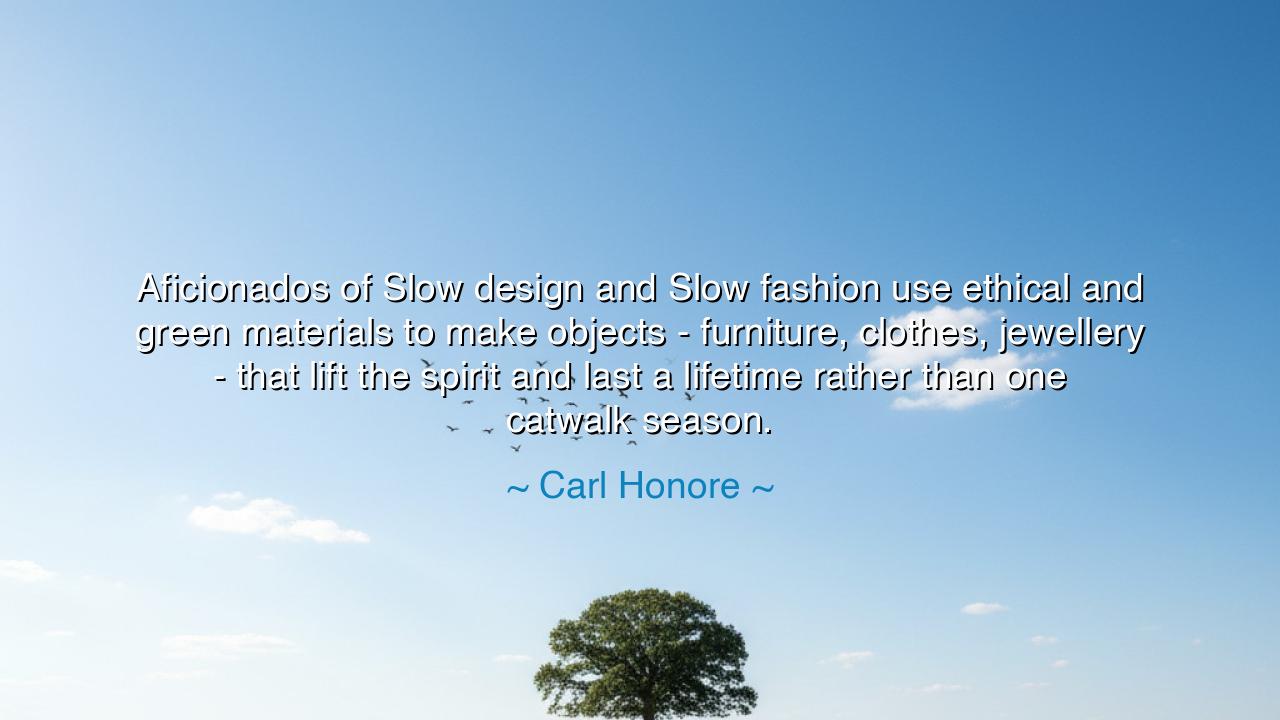
Aficionados of Slow design and Slow fashion use ethical and green
Aficionados of Slow design and Slow fashion use ethical and green materials to make objects - furniture, clothes, jewellery - that lift the spirit and last a lifetime rather than one catwalk season.






"Aficionados of Slow design and Slow fashion use ethical and green materials to make objects – furniture, clothes, jewellery – that lift the spirit and last a lifetime rather than one catwalk season." – Carl Honoré
In these wise words, Carl Honoré, the great advocate of the Slow Movement, reminds us of the sacred rhythm that modern life has forgotten — the rhythm of care, patience, and purpose. When he speaks of Slow design and Slow fashion, he speaks of a philosophy that stands in defiance of haste, waste, and the hunger for the new. It is not merely about the creation of objects, but the cultivation of meaning. To make something slowly is to give it a soul; to craft with intention is to honor both the earth that provides and the human hands that shape. In a world that rushes toward the disposable, Honoré’s message calls us back to the eternal — to beauty that endures, rather than glamour that fades.
The origin of this quote arises from the global Slow Movement, which began as a rebellion against the cult of speed — first in food, then in art, in work, and in living itself. Honoré, through his book In Praise of Slow, became its herald. He saw that in our haste to produce and consume, we have lost the art of cherishing. What began with fast food — the stripping of nourishment for the sake of convenience — has spread to every corner of human life, even to the sacred act of creation. The “Slow” philosophy restores what haste destroys: connection, mindfulness, and respect for time.
Consider the ancient artisans — the weavers of Persia, the potters of Greece, the builders of cathedrals in Europe. They worked not for a season, but for centuries. Their creations were not trends but testaments. Each stroke, each pattern, carried patience, care, and the quiet joy of mastery. The Persian rug that took a year to weave was not an object of fashion; it was an offering to time itself. The cathedral took generations to complete — yet every craftsman who laid stone upon stone did so knowing he was building something for eternity. This is the spirit that Honoré calls us to reclaim — the belief that slowness, when filled with purpose, is a form of love.
But the modern world, drunk on speed, has forgotten this. The fast-fashion empires flood the world with garments made not to last but to be replaced — each piece born from exploitation, destined for landfill. The result is a cycle of fleeting satisfaction and deep emptiness. In contrast, the Slow creator asks: What if we made less, but better? What if each garment, each piece of furniture, each jewel, were made to accompany a soul through life — not as decoration, but as companionship? Such objects “lift the spirit,” as Honoré says, because they hold within them the reverence of the maker and the integrity of the materials.
There is a profound moral truth here. When we choose to create or buy slowly, we are making a pact with the future — a promise not to steal beauty from tomorrow for the comfort of today. A handmade coat, a wooden chair, a ring forged by an artisan’s flame — these are not mere possessions. They are symbols of sustainability, embodiments of balance between man and earth. To live slowly is not to live lazily, but to live consciously, understanding that the worth of a thing is not measured by its price or its novelty, but by the care that went into its making and the joy it continues to give.
History gives us a shining example in William Morris, the 19th-century artist and philosopher who founded the Arts and Crafts Movement. In an age of industrial excess, he fought to restore dignity to craftsmanship. “Have nothing in your house that you do not know to be useful, or believe to be beautiful,” he said — a principle that mirrors Honoré’s teaching. Both men understood that true art is not hurried; it is born of patience, ethics, and reverence for both the material and the human hand.
Lesson: My children, in a world obsessed with speed, choose the way of slowness. Make with care, buy with thought, and cherish what endures. Surround yourself not with things that impress the eye, but with those that feed the spirit. For the fast will always fade, but the slow — the ethical, the mindful, the lovingly made — will last beyond fashion, beyond the fleeting hour, into the quiet permanence of a life well-lived. Remember: what is made slowly, lives long — in the world, and in the heart.






AAdministratorAdministrator
Welcome, honored guests. Please leave a comment, we will respond soon